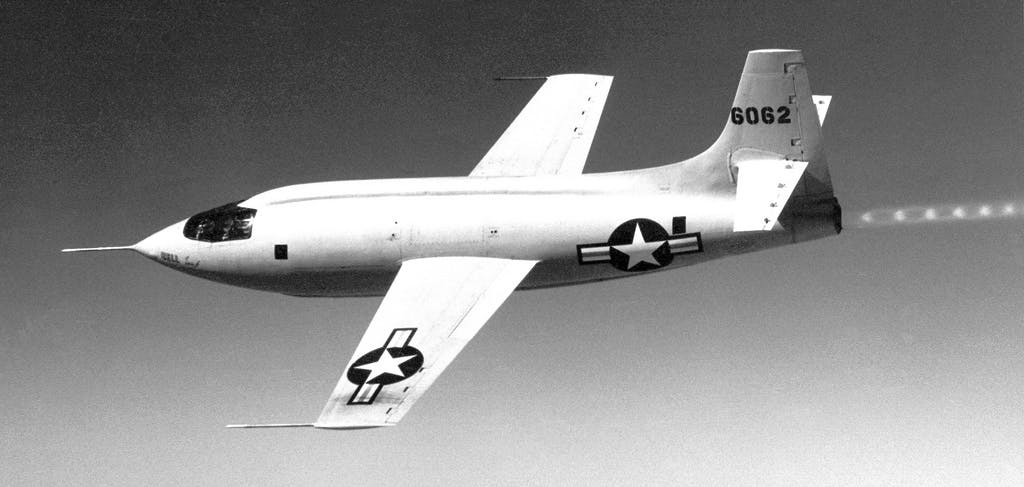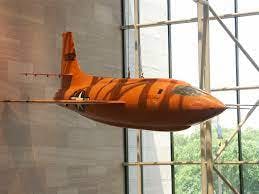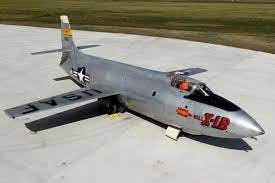Bell X-1: The first airplane to break the sound barrier… sort of

Blog
As soon as humanity began to use technology to move people around the world, we became obsessed with doing it more quickly. How much faster can we get this Roman slave galley to go? If we really pour the coal to this steam locomotive, can we get it to travel two miles every minute? How fast will a Tesla Model S accelerate in Ludicrous Mode? While ships, motorcycles, cars, and trains whetted people’s appetites for speed, it wasn’t until the invention of the airplane that people really started moving.
By 1931, less than 30 years after the Wright brothers’ first flight at Kitty Hawk, racing seaplanes were capable of exceeding speeds of 400 miles per hour. By 1939, the top airspeed record over a 3 kilometer course was raised to 469 mph, set by the Messerschmitt Me 209. Several aircraft exceeded 600 mph in the 1940s, and some pilots arguably flirted with or possibly crossed the sound barrier in dives. But it wasn’t until Chuck Yeager climbed gingerly (he’d broken 2 ribs in a horse-riding accident a couple of days prior) into the cockpit of the Bell XS-1 (Experimental, Supersonic, first model, later shortened to X-1) rocket-powered airplane, released the aircraft from the bomb bay of a modified B-29 Superfortress, and lit the fires of the X-1’s rocket engines that the speed of sound was officially exceeded by a piloted airplane in level flight, on October 14, 1947. Yeager’s big brass ones brought him well-deserved fame, and his feat was immortalized in the Tom Wolfe book The Right Stuff, later made into a kickass movie. But was Yeager really the first human pilot ever to fly faster than the speed of sound? Probably not… if you’re a fan of technicalities.

Did other aircraft break the sound barrier before the Bell X-1?
The Germans claimed their Me 163 rocket-powered interceptor exceeded 700 mph in a dive in 1944, but the altitude was unknown (which means the speed of sound is not able to be determined; more on that below). Modern analysts reason that since the attempt left the tail control surfaces damaged and inoperable, it’s not likely that the speed of sound was exceeded in a survivable fashion. Aerodynamically, the Me 163 was probably not capable of the feat. Similarly, the Germans claimed several times that the Luftwaffe’s Me 262 jet fighter exceeded the speed of sound in shallow dives, but neither evidence nor eyewitness accounts support those claims. Computer-assisted analysis of airflow over the control surfaces suggest that the jet was unlikely to be capable of breaking the speed of sound and remaining controllable. But, since when did the Nazis make unfounded claims for the sake of propaganda? *cough*
Some WWII-era fighter pilots and test pilots certainly flirted with the speed of sound in dives, and many didn’t survive these attempts—whether they were intentional or not. Shockwaves from supersonic propeller tips and near-transonic nose cones caused propellers to disintegrate, and traditionally designed wingtips and tails broke off or became ineffective at speeds close to the speed of sound, earning this seemingly impenetrable limit the “sound barrier,” as it may as well have been a solid wall through which it was not possible to cross. Like the 4-minute mile, breaking the sound barrier was deemed a physical impossibility.
During one high-speed attempt by Squadron Leader Anthony Martindale in April 1944, the reduction gear failed in his Mark XI Spitfire and the propeller ripped off as he reached Mach 0.92 (620 mph). The now tail-heavy aircraft pulled sharply out of the dive, and the G-forces knocked Martindale unconscious and bent the wings upward as the plane climbed higher and higher. He awoke to find his aircraft flying at 40,000 feet, somehow managed to glide his wounded fighter back to base, landed it without power, and emerged unscathed. We imagine someone in the ground crew said “Pip pip,” and handed him a nice hot cup of tea. Stiff upper lip, indeed.
Even during WWII, aerospace engineers were working out designs that would eventually help lead to the breakthroughs necessary for humans to safely exceed the speed of sound. Starting in October 1943, the Miles Aircraft company was tasked by the British Air Ministry with building an aircraft capable of a speed of at least 1,000 miles per hour (1,600 kph) in level flight, which was a highly ambitious task for the day. By 1945, the Miles M.52 prototype was secretly developed but not successfully flown. Miles’ engineers provided blueprints to the Americans, who were also working on a supersonic aircraft, but the Americans never reciprocated and swapped their blueprints, according to the Brits. Regardless, when the M.52 project was made known to the British public in 1946, the government was pressured to renew its efforts. One-third scale, rocket-powered models of the M.52 were made and flown, and achieved Mach 1.38 in level flight (unmanned, of course), which proved that the Miles aircraft’s aerodynamics and “all-moving tail” design were theoretically sound. However, the project was canceled before a manned, full-scale attempt could be made.
WWII flying ace and test pilot George Welch made a plausible claim to have broken the sound barrier two weeks before Yeager, on October 1, 1947, while flying a prototype XP-86 Sabre jet. Eyewitness reports and evidence from instruments strongly imply that Welch may indeed have achieved supersonic speed, though the XP-86 was not considered transonic-capable in that current configuration. Regardless, Welch’s flights were not properly monitored and his claim of beating Bell and Yeager to the punch by 2 weeks is not officially recognized by aviation historians, despite some considerable controversy involving Welch and his proponents.
So, the first officially recognized, piloted aircraft that broke the sound barrier in level flight was the Bell X-1 on October 14, 1947. Yeager achieved a maximum speed of Mach 1.06 that day. (The XP-86 officially achieved supersonic speed on April 26, 1948.)

How fast is the speed of sound, and how fast did the Bell X-1 fly?
So, how fast is the speed of sound, actually? It depends. In 1738, the Academy of Sciences in Paris measured the earliest precise experimental value for the speed of sound at 332 meters per second, and they came extremely close to the presently accepted value of 331.29 meters per second at 0° C (1,086.9 feet per second, or 741.06 miles per hour at 32° F) at sea level. The temperature of the air is important, because the speed of sound varies depending on the temperature of the air through which the sound waves move. Gas molecules move more slowly when they’re cold, so the speed of sound drops as temperatures drop.
The speed of sound is also impacted by air density, which is why the speed of sound is always correctly cited at a certain elevation. However, in the Earth’s atmosphere, the primary factor impacting the speed of sound is air temperature. This is because, for any given ideal gas with constant heat capacity and composition, the effects of decreased pressure of altitude and decreased density cancel each other out, leaving only the residual effect of temperature. At a constant temperature, increased air pressure has no effect on the speed of sound, since air density will also increase, and since pressure and density have equal but opposite effects on the speed of sound, the two factors cancel each other out exactly.
Effectively, the takeaway from all of this is that in the Earth’s atmosphere, the speed of sound in air is essentially dependent solely upon temperature, and the speed of sound at sea level — assuming a more realistic air temperature of 59° Fahrenheit (15° Celsius) — is 761.2 mph (1,225 kph).
However, at an altitude of between 35,000 and 65,000 feet, the range of altitude in which Chuck Yeager in his Bell X-1 first broke the sound barrier, the speed of sound at the typical temperature of -70° F (-57° C) is 295 m/s, or around 660 mph. As far as exactly what “Mach 1” meant on October 14, 1947, sources vary. The Smithsonian’s National Air and Space Museum says “the X-1 reached a speed of 1,127 kilometers (700 miles) per hour, Mach 1.06, at an altitude of 13,000 meters (43,000 feet).” Another source says 670 mph. Yet another says 1,299 kph, or 807.2 mph. Regardless, the sound barrier (whatever it happened to be that day) was officially broken, although the US government kept it a secret for months. The story of Yeager’s October 14 flight was leaked to a reporter from the Aviation Week magazine on December 20, 1947, and the Los Angeles Times featured the story as headline news in their December 22 issue. The Air Force threatened legal action against the people who published the story, but none ever occurred once word got out and public reaction was so favorable. Those pesky aviation journalists. Tsk, tsk.
Was the X-1 simply mothballed and shipped to the Smithsonian once the deed was done? Certainly not. That little orange bullet had more in her, and flew 77 more times before being retired. On March 26, 1948, again with Yeager at the controls, the X-1 reached a speed of 957 mph, or Mach 1.45, at an altitude of 71,900 feet (21,900 meters). This was the highest speed and the greatest altitude ever reached by a manned aircraft up to that time.
The right stuff, indeed.
–By Jeff Davis, Intergalactic Scribe
Sources:
https://airandspace.si.edu/collection-objects/bell-x-1/nasm_A19510007000
https://www.bbc.com/future/article/20160505-the-spitfires-that-nearly-broke-the-sound-barrier
http://www.rogerdarlington.me.uk/Mach.html
https://en.wikipedia.org/wiki/Flight_airspeed_record